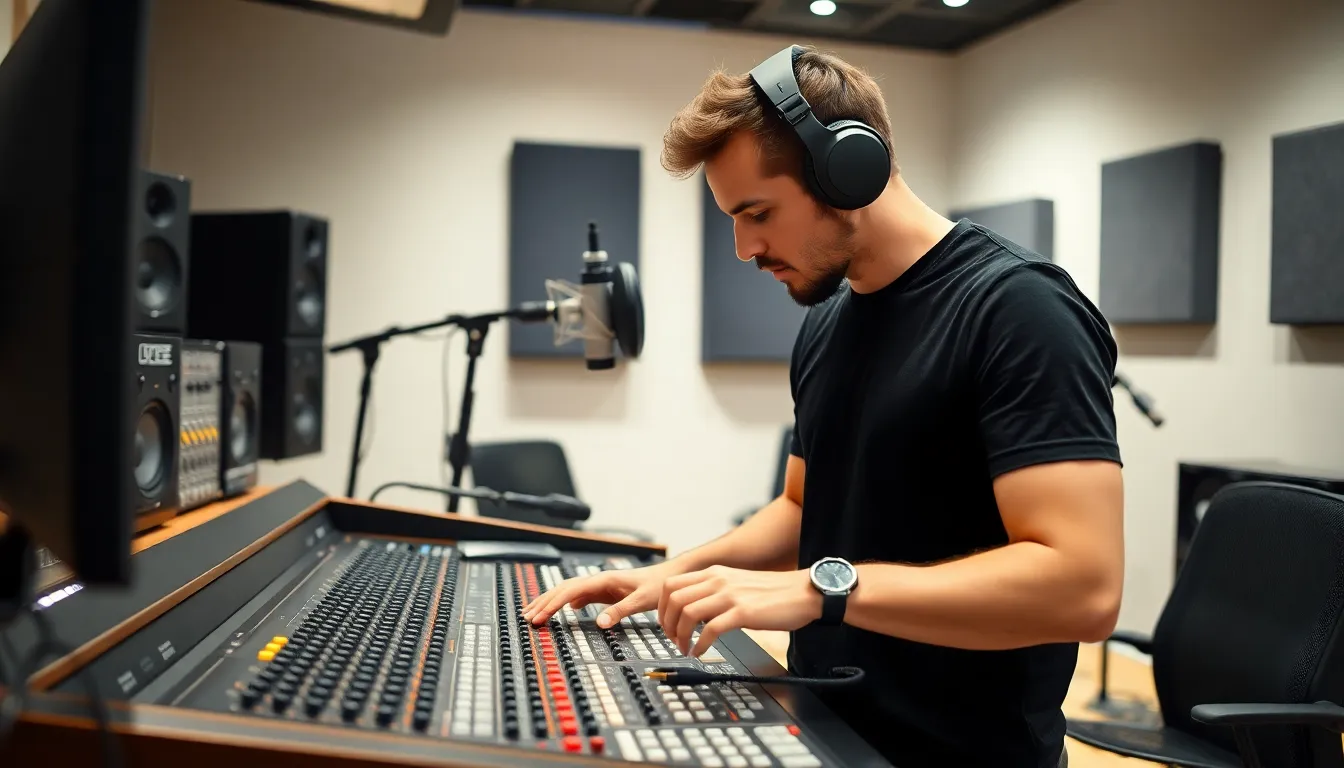In a world where audio quality can make or break the mood, balanced audio technology steps in like a superhero in a soundproof cape. It’s the secret sauce that transforms muddled noise into crystal-clear symphonies, ensuring every note hits just right. Whether you’re jamming to your favorite tunes or diving into a podcast, balanced audio makes sure you hear every whisper and roar without the annoying hiss.
Table of Contents
ToggleWhat Is Balanced Audio Technology?
Balanced audio technology enhances audio quality by reducing interference and noise. This system utilizes two signal wires along with a ground wire to transmit audio signals. The two signal wires carry the same audio information but with opposite polarity. This design allows any noise picked up during transmission to cancel itself out at the receiving end.
Applications of balanced audio technology include professional audio systems, recording studios, and live sound environments. It effectively minimizes hum and buzz, particularly in long cable runs where unbalanced systems are more prone to interference. Equipment such as microphones, mixers, and amplifiers often incorporate balanced connections to ensure clear sound quality.
Characteristics of balanced audio include a higher tolerance for distance, making it suitable for larger spaces. Many industry professionals prefer XLR and TRS connectors for their balanced capabilities. These connections maintain audio integrity, even in electrically noisy environments.
Listeners benefit from the enhanced clarity and precision that balanced audio technology provides. With improved sound quality, people experience music and podcasts as intended by the creators. This technology represents a standard in clarity, making it an essential component for audiophiles and professionals alike.
Benefits of Balanced Audio Technology

Balanced audio technology offers significant advantages to audio professionals and enthusiasts. This technology enhances clarity and precision, enabling listeners to appreciate sound as the creators intended.
Improved Sound Quality
Enhanced sound quality emerges as one of the key benefits of balanced audio technology. This system utilizes two signal wires to ensure that audio maintains integrity during transmission. Professionals often note that this method leads to a richer, fuller sound, providing a better listening experience across diverse audio environments. Musicians and sound engineers frequently observe a noticeable difference in recordings made with balanced connections. In competitive scenarios like live performances or studio recordings, well-defined audio clarity becomes essential for achieving the desired impact on the audience. Thus, balanced audio significantly elevates the overall sound quality.
Noise Reduction
Noise reduction plays a critical role in the effectiveness of balanced audio technology. By employing a dual-wire system, this setup effectively cancels out unwanted interference. Professionals often use balanced connections in environments prone to electrical noise, such as large venues or studios. Audiophiles appreciate how this technology minimizes hum and buzz commonly associated with conventional audio systems. As a result, listeners enjoy a more immersive experience, free from distractions. The advanced design also accommodates long cable runs without compromising sound quality, making it ideal for extensive setups. Therefore, noise reduction is a defining feature that enhances audio clarity significantly.
How Balanced Audio Technology Works
Balanced audio technology relies on several key principles to enhance sound quality. It utilizes a system that significantly reduces unwanted noise interference during audio transmission.
The Concept of Phase
Phase refers to the position of a sound wave in relation to time. In balanced audio systems, two identical audio signals are transmitted simultaneously, but one signal is inverted. This phase inversion leads to cancellation of noise when both signals recombine at the receiving end. Such a method ensures that any electromagnetic interference affects both signals equally. As the noise travels, it cancels itself out, preserving the integrity of the intended audio signal. This concept is vital for maintaining clarity and fidelity in audio playback.
Differential Signal Transmission
Differential signal transmission plays a crucial role in balanced audio systems. Each balanced connection utilizes two signal wires that carry opposite audio signals. By doing so, it effectively negates noise that may be introduced along the cable run. Any interference that affects one wire impacts the other similarly, allowing the receiver to disregard it. This process not only minimizes hum and buzz but also enhances overall audio quality. Reduced noise levels are essential for professional applications like live sound and recording. As a result, balanced audio technology ensures optimal listening experiences.
Applications of Balanced Audio Technology
Balanced audio technology finds broad applications across various audio environments. It enhances sound quality in numerous settings where clarity is essential.
Professional Audio Equipment
In professional audio equipment, balanced connections are standard. Equipment like mixing consoles, microphones, and audio interfaces widely uses this technology to ensure high fidelity. Active usage of balanced connections prevents noise interference during recordings and live sound reinforcement. Engineers often rely on balanced signals for lengthy cable runs since these connections effectively minimize hum and buzz. Resulting clarity elevates performances in studios and venues alike. Professionals recognize the importance of such connections for delivering precise sound reproduction.
Home Audio Systems
Home audio systems increasingly benefit from balanced audio technology. Audiophiles frequently utilize devices with balanced outputs to achieve superior sound experiences. Using balanced connections in home theaters enhances audio fidelity during movie playback. Different components like amplifiers and speakers utilize this technology to reduce noise interference. Effectively, these connections allow for a richer soundstage that captivates listeners. Investments in balanced systems yield significant improvements in overall audio enjoyment.
Balanced audio technology stands as a cornerstone in achieving superior sound quality across various environments. Its ability to minimize noise interference not only enhances the listening experience but also ensures that audio remains clear and engaging. This technology is indispensable for professionals in recording studios and live sound settings where clarity and precision are paramount.
As home audio systems evolve, the adoption of balanced connections continues to rise, allowing audiophiles to enjoy a richer soundscape. With its proven benefits and wide-ranging applications, balanced audio technology is set to remain a key player in the pursuit of optimal audio fidelity. Embracing this technology means embracing a world where sound is experienced as it was meant to be heard.




